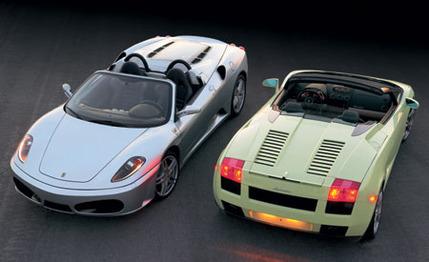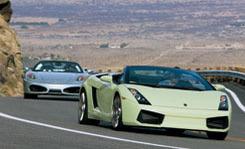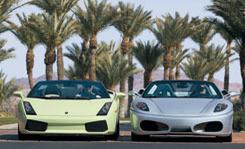
 Comparison Tests
Comparison Tests
In March we brought you a first-drive report on the new topless Gallardo, which was headlined thus: "Lamborghini tries to one-up the neighbors in Maranello. And succeeds." That's a pretty bold assertion, particularly in light of the Gallardo coupe's second place in our "Lords of Envy" supercar showdown last August -- second, we should add, behind the Ferrari F430 coupe.
There was foundation for our one-up speculation. When the Lamborghini engineers subtracted the Gallardo's solid top, they added more muscle, bumping the output of the 5.0-liter V-10 from 493 horsepower at 7800 rpm to 512 at 8000. That's 29 more horses than the V-8 in the Ferrari F430 makes. Its top speed outdid the Ferrari by 9 mph (to 195). Beyond that -- and probably more significant -- the topless Gallardo generates even higher visual wattage than its coupe counterpart.
But even so, this is clearly a situation that calls for more than mere speculation. This calls for instrumented test data. Hands on at high speeds. Tops down. Tops up. Mountain roads. Fast sweepers. Decreasing radii. Switchbacks. Urban stop-and-go. Freeway traffic dissection. We do this in the spirit of pure research on your behalf, of course. Barely a scintilla of self-indulgence.
Since the U.S. market accounts for more than 40 percent of all its sales, and a hefty chunk of that percentage goes to California, Lamborghini chose the Los Angeles auto show for the official unveiling last January of its new convertible, where it played to rave reviews. The design, conceived by Lamborghini Centro Stile, entailed at least as much engineering work as it did styling, and the operation of the electrohydraulic (there are six hydraulic rams) power top is an event worth watching. The carbon-fiber lid covering the engine bay rises off its moorings, retreats rearward, the top folds itself up like something from a Harry Potter movie, stuffs itself out of sight, whereupon the cover settles back into place. The whole operation takes about 20 seconds.
Creating a convertible inevitably adds up at the scales, and that's certainly true for the Lambo. In addition to the top mechanism, the spyder has added structural stiffening along the sills, and the A-pillars include automatic pop-up rollover reinforcement integrated with the airbag system. Bottom line: Our "Lords of Envy" Gallardo coupe weighed 3520 pounds. This spyder scaled in at 3820.
Ferrari's droptop is also new, at least to U.S. streets -- our test car, in fact, was fresh off an air freighter. But its weight gain is much more modest, only 80 pounds heavier than the coupe we tested last August. So the Lambo may have one-upped its Modenese rival in terms of horsepower, but it lost ground in the power-to-weight index -- not a very good start for this return match.

 In case you're wondering about the other Envy Lords -- there were six cars in the August comparo -- we typically omit the low-placed finishers from rematches. We would have been pleased to make this a three- or four-way fight if we'd been able to field an Aston V-8 convertible or Porsche 911 Turbo cabrio, but neither was available at post time. And anyway, who has a better grip on the passionate roadster business than these two Italians? You might object that one of them speaks with a German accent, but let's not quibble. Audi's stewardship has clearly rescued Lambo from oblivion, and if Ferruccio Lamborghini were still with us, we think he'd cheerfully acknowledge this car as one of his own.
In case you're wondering about the other Envy Lords -- there were six cars in the August comparo -- we typically omit the low-placed finishers from rematches. We would have been pleased to make this a three- or four-way fight if we'd been able to field an Aston V-8 convertible or Porsche 911 Turbo cabrio, but neither was available at post time. And anyway, who has a better grip on the passionate roadster business than these two Italians? You might object that one of them speaks with a German accent, but let's not quibble. Audi's stewardship has clearly rescued Lambo from oblivion, and if Ferruccio Lamborghini were still with us, we think he'd cheerfully acknowledge this car as one of his own.

 Our test took us from the Los Angeles area to the mountain roads around Borrego Springs in the desert east of San Diego, and ultimately back again. As always, the journey ended too soon. But a solid preference emerged, as well as a thought for the day: In the great scheme of things, it's fair -- though sad--to say that very few of us will ever possess cars such as these. There are all sorts of rationales to make us feel better about this -- they're not even remotely practical; they consume vast quantities of irreplaceable energy; they incite behavior that can be viewed (at least by some) as antisocial; they're ridiculously expensive; they have very limited value as transportation compared to, say, minivans.
Our test took us from the Los Angeles area to the mountain roads around Borrego Springs in the desert east of San Diego, and ultimately back again. As always, the journey ended too soon. But a solid preference emerged, as well as a thought for the day: In the great scheme of things, it's fair -- though sad--to say that very few of us will ever possess cars such as these. There are all sorts of rationales to make us feel better about this -- they're not even remotely practical; they consume vast quantities of irreplaceable energy; they incite behavior that can be viewed (at least by some) as antisocial; they're ridiculously expensive; they have very limited value as transportation compared to, say, minivans.
On the other hand, these are cars that broadcast an aura of magic that's absent in lesser rides. The world would be diminished if they were to disappear.